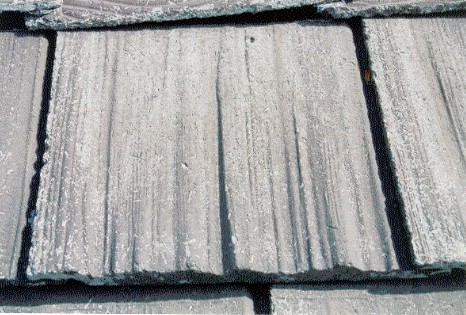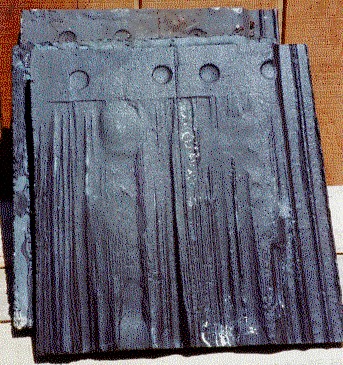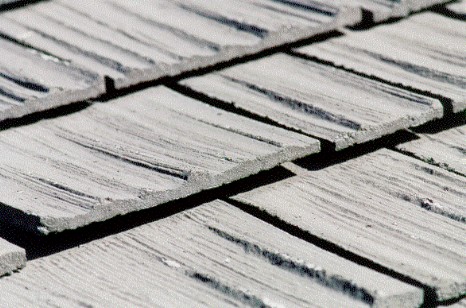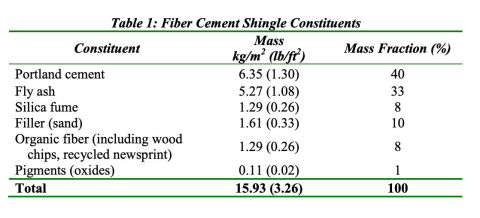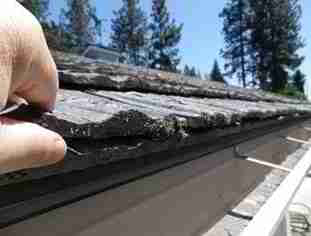 American Cemwood Roof Shake Litigation
American Cemwood Roof Shake Litigation
Other Roof Product Settlement Notices & History
Cemwood, Generic, Masonite, & Monier Lifetile Roofing
- POST a QUESTION or COMMENT about American Cemwood Roof shake class action settlement, product identification, failures, & repair advice
American Cemwood™ roofing failures & warranty information, also information about cement roof shakes and shingles from Monier
this website provides information about American Cemwood fiber cement roofing shingles, shakes, and roof failures, including roofing claims information for Permatek, Permatek II, Royal, Cemwood, and Cascade shakes, and Pacific Slate and Trieste tiles or roof "shingles" and includes advice for home inspectors, home buyers, and homeowners where these roofing products are used.
We discuss claims for qualifying damage to American Cemwood roofing tiles and shakes, including but not limited to: Permatek, Permatek II, Royal, Cemwood, and Cascade shakes, and Pacific Slate and Trieste tiles. List of fiber cement & hardboard roof shingle failures, warranty claims, manufacturers.
InspectAPedia tolerates no conflicts of interest. We have no relationship with advertisers, products, or services discussed at this website.
- Daniel Friedman, Publisher/Editor/Author - See WHO ARE WE?
American Cemwood Roofing Class Action Lawsuit Settlement Details
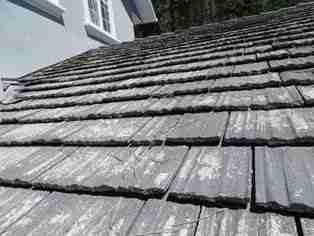
Several hardboard-based and fiber cement based roofing products have not performed as well as originally anticipated, experienced early failure, and were the subject of roof warranty claims.
Masonite Woodruff, Cemwood, Hardishake/Hardislate, CalShake and Fire Free are examples of product names that have suffered these problems.
Article Contents
- WOOD FIBER CEMENT ROOF PROBLEMS & FAILURES
- AMERICAN CEMWOOD ROOF FAILURE CLAIMS
- IDENTIFY AMERICAN CEMWOOD, PERMATEK SIMILAR ROOFS
- FIBERBOARD & FIBER CEMENT ROOF SHINGLE WARRANTY CLAIMS COMPANIES & WEBSITES
- RESEARCH & REFERENCES: AMERICAN CEMWOOD & OTHER CONCRETE OR COMPOSITE ROOF FAILURES
...
Problems and failures in wood fiber cement roofs
Our page top photo and photo at left of an American Cemwood roof was provided courtesy of Canadian home inspector Hugh Cairns [3].
The roof shown in these two photos by Mr. Cairns was installed in Kelowna, BC in 1991.
As stated in Best Practices Guide to Residential Construction (printed text) and online
in CLAY, CONCRETE, FIBER CEMENT ROOF TILE CHOICES:
Early generations of fiber-cement roofing products using asbestos fibers were used successfully in the United States for over 50 years.
Articles discussing these products, including cement-asbestos roofing shingles, corrugated roofing, and related products are found
at ASBESTOS & FIBER CEMENT ROOFING.
Newer formulations of fiber cement roofing tiles introduced in the 1980s and 1990s used wood fibers instead of asbestos and were marketed widely in the western United States as a fire-resistant alternative to wood shakes.
Made from a mixture of Portland cement and wood fibers, they weighed 400 to 600 pounds per square and were designed to imitate slates or wood shakes.
They promised excellent resistance to insects, fungus, fire, and weathering and carried warranties ranging from 25 to 50 years.
Within five years of installation, however, many of the fiber-cement shakes began to deteriorate. Problems included surface crazing, cracking, delamination, and softening and resulted in a number of lawsuits against key manufacturers and several companies abandoning the product.
The problems and failiures in wood fiber cement roofing products were generally linked to high water absorption, which created an alkaline solution that was corrosive to the wood fibers.
Some fiber cement roofing products have fared better than others. In general, fiber cement roof products that are steam-cured in an autoclave will have lower water absorption, but they tend to be more brittle.
Comparing Asbestos Cement Roof Shingles to American Cemwood Shingles
Our photo above is of asbestos cement roofing shingles, a product that can usually be easily distinguished from American Cemwood roofing shakes and other members of that product family. We provide further Cemwood roofing identification information below.
For information about fiber cement roofing inspection, diagnosis, repair, and repalcement,
see ASBESTOS & FIBER CEMENT ROOFING.
Also see MASONITE WOODRUF FIBERBOARD ROOFING and for similar building siding product
see SIDING HARDBOARD IDENTIFICATION & CLAIMS for hardboard siding product failures and warranty claims.
...
American Cemwood Roofing Claims Contact Information
The following information was provided by the American Cemwood Claims Administrator. Independent Claims Administrator for American Cemwood Roofing Litigation Settlement, P.O. Box 162, Lancaster, CA 93584. Contact the Cemwood Administrator at 1-800-708-3266. [Don't bother trying this telephone numnber, it is no longer functional - Ed.]
Watch out: the current American Cemwood Claims Administrator websites in public distribution not only do not connect to a useful service, the telephone number directs callers to a marketing firm: win a free trip to the Bahamas, and the website directs readers to a "made-for-Ad-Sense" website that provides only links to pages with advertisements, no useful information.
Quoting from original source (that includes product photos): http://www [BADSITE] cemwoodclaims.com/identify [BADSITE] html
- A $75 million additional settlement has been proposed in a class action lawsuit about whether roofing shakes manufactured by American Cemwood Corporation are defective. Together with a partial settlement approved in May of 2000, the total settlement fund is now $140 million.
- The settlement pays valid claims for qualifying damage to American Cemwood roofing tiles and shakes, including but not limited to: Permatek, Permatek II, Royal, Cemwood, and Cascade shakes, and Pacific Slate and Trieste tiles.
- Your legal rights are affected whether you act or not. Read the AMERICAN CEMWOOD ROOFING SHAKES SETTLEMENT NOTICE [PDF file hosted at InspectApedia] carefully
- SUPERIOR COURT FOR THE STATE OF CALIFORNIA, COUNTY OF SAN JOAQUIN QUESTIONS? CALL 1-800-708-3266 OR VISIT WWW.CEMWOODCLAIMS.COM. [The American Cemwood Roofing Shakes Settlement Notice is quoted below]
The Plaintiffs said that the Defendants failed to design, formulate, and test roofing shakes manufactured by American Cemwood Corporation adequately before selling them as durable and suitable roofing products.
They said that the Defendants should have known that the shakes failed prematurely, but that they did not take them off the market until April of 1998. Claims about personal injury and emotional distress are not affected by this case.
The Defendants have denied, and continue to deny, each and every allegation and all charges of wrongdoing or liability of any kind.
In a class action, one or more people called “Class Representatives” (in this case, Roy Richison is one of the Class Representatives) sue on behalf of people who have similar claims.
All these people together are
a “Class” or “Class Members.” One court resolves the issues for all Class Members.
The Court did not decide in favor of the Plaintiffs or the Defendants. Instead, both sides agreed to a
settlement. That way, they avoid the cost of a trial, and the people affected will get compensation.
A partial settlement was previously reached with Weyerhaeuser Company Limited (formerly known as MacMillan Bloedel Limited) and Weyerhaeuser (U.S.A.), Inc. (formerly known as MacMillan Bloedel (U.S.A.), Inc.).
Under the partial settlement, a $65 million settlement fund was established, plus a $40 million guaranty to be paid if an additional settlement was not reached with American Cemwood and its insurers ($105 million in total), and attorneys for the Class Members pursued litigation against the other Defendants, including American Cemwood, and the Defendants’ insurance carriers.
Weyerhaeuser has already paid $20 million of the guarantee, which will be returned if and when the additional settlement is approved and any appeals are resolved. To date, about $48 million has been paid to claimants.
The settlement is currently paying valid claims at a rate of $125 per “square” of roofing shakes.
Notice of the partial settlement and the certification of a Class as to all the Defendants was given to Class Members in 2000, which also gave Class Members the option to exclude themselves from the Class.
On May 26, 2000, the Court gave “final” approval to the partial settlement, and potential Class Members who did not exclude themselves are legally bound by the settlement and the class certification decision, and can’t bring a separate suit against any of the Defendants about the claims in this case.
The terms of the previous settlement can be found in the Partial Settlement Agreement at www.cemwoodclaims.com.
...
How to Identify American Cemwood Roofing Shakes, Permatek Shakes, and related products
There are two primary ways to determine whether or not you have Cemwood or Permatek shakes.
First, if you were involved with the reroofing of your home, you may have your own Cemwood/Permatek records. Such records may include a warranty, contract for installing the product, or proof of payment.
A second way to determine if you have Cemwood or Permatek shakes is to carefully examine the product on your roof. Cemwood and Permatek shakes are formed of a composite of Portland cement and wood fibers. They are a textured product and replicate the look of traditional wood shake.
The Cemwood shakes at left appear to ahve been coated/painted in an attempt to prolong roof life.
Watch out: when inspecting a Cemwood any other roof, be careful about walking on cemwood roofs or any other roof surface that is fragile, as you are likely to damage the roof and may convert a roof of uncertain future life to a need for an immediate re-roof job.
Stay off of roofs that are fragile, wet, slippery, moss covered, steep, or have any other safety concern that leaves you uncertain about your abiltiy to make a safe on-roof inspection.
Cemwood shakes are tapered. They are 22 inches in length and come in random widths of 12, 7 and 5 inches.
Cemwood roofing shakes were sold in two colors: driftwood (light grey) and umber (dark brown).
On the top side of Cemwood shakes, above the exposure line, the letters "AC" are sometimes imprinted on each shake. [So you'd need to remove some of the roofing to see this marking.]
Permatek Shakes Permatek and Permatek II shakes are uniform in size: 14 inches wide by 14 ½ inches long, and have four different shake-detailed patterns.
Permatek fiber cement roofing shakes were sold in a number of colors: mocha (medium brown), driftwood (light gray), umber (dark brown), greyflash (dark grey) and tanflash (tan).
The word "PERMATEK" is sometimes imprinted on the back side of each shake.
...
List of Fiberboard & Fiber Cement Roof Shingle Warranty Claims Companies & Websites
- Cemwood Roof Shakes: Information about American Cemwood roofing shakes and related products is
at AMERICAN CEMWOOD ROOFING [The article above on this page]
Contact information is at: American Cemwood - imitation wood shakes crack, swell and discolor. The American Cemwood roofing settlement includes Cemwood Shakes, Permatek Shakes, Permatek and Permatek II. Cascade Shake, Trieste Tile, Pacific Slate, Permatek II and Royal Shake.
Here is the AMERICAN CEMWOOD ROOFING SHAKES SETTLEMENT NOTICE [PDF file hosted at InspectApedia]
Watch out: the current (January 2015) American Cemwood Claims Administrator websites in public distribution [Web page image shown at above left] not only do not connect to a useful service, the telephone number directs callers to a marketing firm: win a free trip to the Bahamas, and the website directs readers to a "made-for-Ad-Sense" website that provides only links to pages with advertisements, no useful information. [January 2015]
Watch out: American Cemwood Claims administrator: [BAD NUMBER] 1-800-708-3266 - now directs callers to a marketing service.
Class action settlement site was previously: www [BADSITE] cemwoodclaims [BADSITE] com or for help identifying Cemwood or Permatek shakes on a roof. This website auto-forwards to the bogus website listed just above: http://www.cemwoodclaims [BADSITE] com/identify.htmlWATCH OUT: AMERICAN CEMWOOD CLAIM SITE FRAUD ALERT: the Claims Administrator telephone number 1-800-708-3266 shown in our original article now connects to a marketing company who will contratulate you by promising you a cruise to the Bahamas!
WATCH OUT: cemwood claims wesite FRAUD ALERT: the original American Cemwood Claims administrator site given in most website references for this topic now auto-forwards readers to http://ww5.cemwoodclaims [BADSITE] com/ which is a "Made for AdSense" site that only provides links to advertisements. At least that's All I could find there - Daniel F.
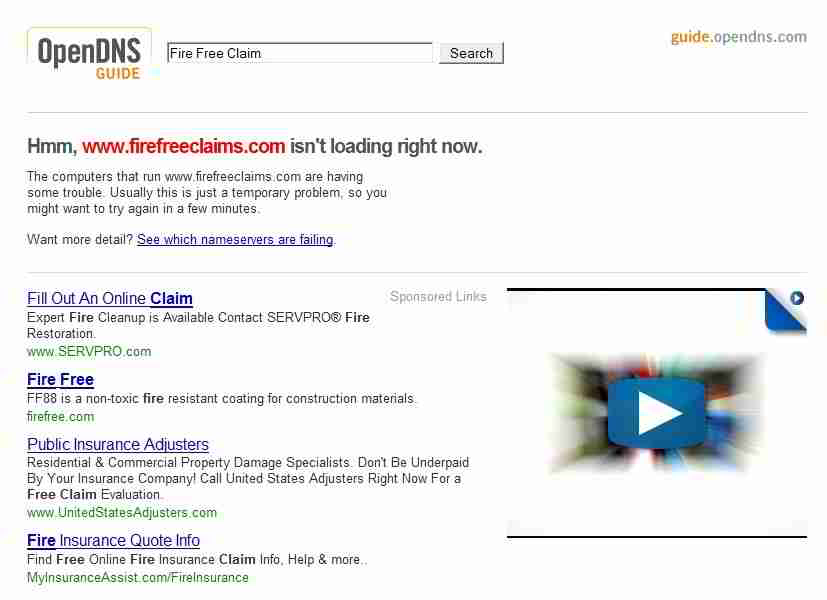
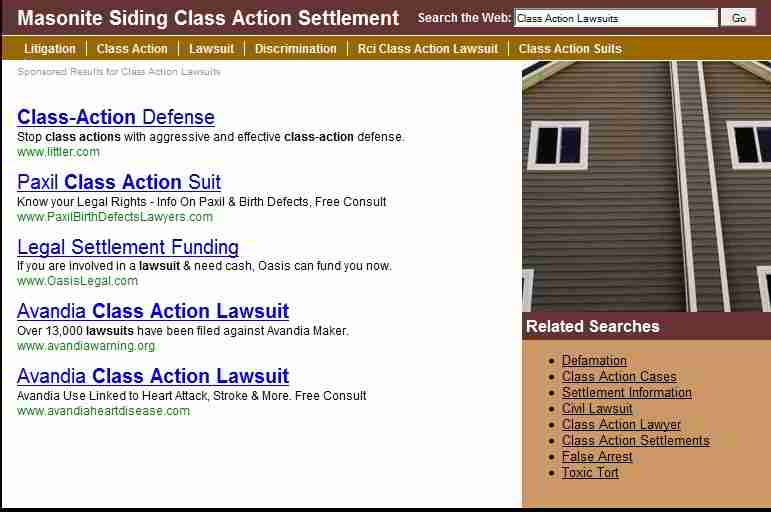
- MASONITE WOODRUF® ROOFING OR MASONITE OMNIWOOD® SIDING LAWSUIT SETTLEMENT NOTICE - PDF file
- Masonite fiberboard Roof Shingles & Siding: Information about Masonite roofing products is
at MASONITE WOODRUF FIBERBOARD ROOFING.
Contact information is at: Chicago, IL, 312-750-0900 . Cass action settlements involving masonite hardboard, omniboard, woodruff shingles.
Watch out: We found the "official" website www.masoniteclaims.com [now an Image file shown at above left] not useful
basically clicking on its links simply present advertisements so we have disabled the link and provide just an image of the web page (above left) - web search 09/28/2010
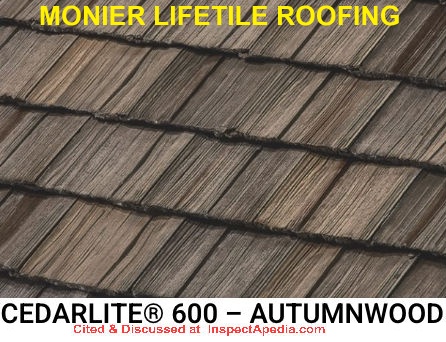
- Monier Lifetile was a U.S. company in California, acquired by Boral in 2010; The company is no longer in operation. The original "100 year life" promised for their concrete roofing was backed by a 50-year warranty.
Monier Cedarlite Lifetile is a concrete roof tile sold in high and low barrel tile shapes a well as a shake version. Shown here is Cedarlite (R) 600 Autumnwood.
Contact Monier Lifetile, 7575 Irvine Center Drive, Suite 100, Irvine, CA 92618 USA, Tel: (800) 571-TILE (8453) (Website not working as of this posting - Ed.) Email (may be obsolete): monierlifetile@salessupport.com The company's manufacturing plants were in the U.S. and Mexico.
We *think* that as the company is no longer in business Boral may not be covering warranty claimes for Monier. - Ed.
However it may still be possible to buy replacement Monier tiles from some suppliers such as at All Points Tile & Slage, Web: allpointstile.com/brands/monier-lifetile/
Their roofing products were distributed in North America by a range of roofing suppliers according to this FTC document
UNITED STATES OF AMERICA COMPLAINT BEFORE FEDERAL TRADE COMMISSION, In the Matter of MONIER LIFETILE LLC, a corporation; BORAL LTD., a corporation; and LAFARGE S.A., a corporation. Docket No. 9290 COMPLAINT
In Austraila, Monier concrete roofing is produced by Monier LLC, producing both concrete and flat terra cotta roof tiles. Web: www.monier.com.au/products/concrete-tiles

- FireFree Plus fiber cement Roof Shakes: Re-Con Building Products roof tiles composed of 2/3 Portland Cement and 1/3 wood cellulose fiber crack, swell and discolor.
Casagrande, June, "Roofing Maker Covers Its Losses", LA Times, 2 September 2001, retrieved 2019/08/19 original source: https://www.latimes.com/archives/la-xpm-2001-sep-02-re-41182-story.html
Excerpt:
Within just a few years of installation, however, the cement and cellulose fiber tiles on homes in Northern California and throughout the Pacific Northwest began to warp and twist. Though there’s no evidence that the faulty tiles present an increased risk of fire, they have damaged the appearance of homes and they pose increased chances of leaking and other problems.
A Contra Costa County Superior Court judge awarded an $18.6-million class-action settlement in June of 2001 to homeowners of FireFree roofs manufactured and installed from December 1993 to November 1997. Homeowners with failing FireFree roofs covered in the suit had until Jan. 15, 2007, to file claims for FireFree™ Roofing Shakes.
FireFree Shakes Class action settlement site:
Watch out: We found the "official" website www ... FIREFREECLAIMS ... com [now an image file also shown at above-left ] not useful - basically clicking on its links simply present advertisements - web search 09/28/2010 & 03/01/2011
Re-Con Building Products, Inc., a subsidiary of Stone Mountain Holdings, Inc., went out of business and into receivership in October, 2007.
Also see Fire Free Plus Roofing, 4850 SW Scholls Ferry Road # 203, Portland, OR 97225-1692, Tel: (205) 879-5420
- GENERIC FIBER CEMENT SHINGLES [PDF] Properties, retrived 2019/08/19 original source: https://ws680.nist.gov/bees/ProductListFiles/Generic%20Fiber%20Cement%20Shingles.pdf
Excerpt:
Fiber cement shingles are considered a synthetic equivalent to wood shingles. In general, these roofing materials can last longer that wood or asphalt products. In the past, fiber cement shingles were manufactured using asbestos fibers. Now asbestos fibers have been replaced with cellulose fibers.
Properties of fiber cement shingles are given in the NIST table below, excerpted from the article above. You'll see that the total weight is about 3.26 lb. / sq.ft. for this version of the product. Other fiber cement shingle products will differ in weight.
George Podrug provided Masonite Woodruf™ roofing information for home inspectors in 1999.
...
Research & References: American Cemwood & Other Concrete or Composite Roof Shingle Failures
- [1] American Cemwood Claims Administrator, Independent Claims Administrator for American Cemwood Roofing Litigation Settlement, P.O. Box 162, Lancaster, CA 93584. 1-800-708-3266. Websearch 8/18/2010, Web: cemwoodclaims.com - original source: http://www.cemwoodclaims.com/
For information regarding how to participate in, or exclude yourself from, the Settlement and the Class, object to the Settlement, or for a complete and detailed Notice, Claim Form, Prior Release Claim Form, Registration Form - [2] AMERICAN CEMWOOD ROOFING SHAKES SETTLEMENT NOTICE [PDF] web search 08/18/2010, original source: cemwoodclaims.com/images%5Cpdfs%5Ccemwood-longformnotice.pdf
- [3] Cairns, Hugh, Subject 2 Home Inspections, is a professional home inspector in British Columbia, Canada, with offices in Kelowna B.C. and Kamloops B.C.
He contributed the American Cemwood photo used at the top and within this article. Mr. Cairns can be contacted by telephone: 250-808-5777, or by email: okanagan@subject2homeinspections.com - Harris, Samuel, Building Pathology, Deterioration, Diagnostics, and Intervention, Samuel Y. Harris, P.E., AIA, Esq., ISBN 0-471-33172-4, John Wiley & Sons, 2001 [General building science-DF] ISBN-10: 0471331724 ISBN-13: 978-0471331728
- [4] Masonite Woodruf roofing class action lawsuit: On January 6, 1999, the Circuit Court of Mobile County, Alabama, granted final approval to a settlement in the lawsuit known as Smith, et al. v. Masonite, CV-98-2447.
The Settlement provides a program for eligible claimants to recover the costs associated with damage caused by the installation and incorporation of Masonite Woodruf roofing. For more information please call 1-800-256-6990. ® Woodruf is a registered trademark of Masonite Corporation. See masoniteclaims.com and also see this law firm's
MASONITE WOODRUF CLASS ACTION LITIGATION NOTICE [PDF] - [5] MASONITE WOODRUF® ROOFING OR MASONITE OMNIWOOD® SIDING LAWSUIT SETTLEMENT NOTICE - PDF file
- [6] Masonite, Chicago, IL, 312-750-0900 (George Podrug provided Masonite Woodruf roofing information for home inspectors in 1999
- Watt, David, Building Pathology: Principles and Practice, David Watt, Wiley-Blackwell; 2 edition (March 7, 2008) ISBN-10: 1405161035 ISBN-13: 978-1405161039
...
...
Continue reading at FIBERBOARD ROOFING & FIBER-WOOD ROOFING or select a topic from the closely-related articles below, or see the complete ARTICLE INDEX.
Or see AMERICAN CEMWOOD ROOFING CLAIM FAQs - questions & answers posted originally at this page
Or see these
Recommended Articles
- AMERICAN CEMWOOD ROOFING
- ASBESTOS & FIBER CEMENT ROOFING - home - page top photo of material described as asbestos-cement roofing looks a lot (from the ground) like wood-fiber cement roofing
- CLAY, CONCRETE, FIBER CEMENT ROOF TILE CHOICES
- FIBER CEMENT PRODUCT MANUFACTURERS
- FIBER CEMENT PRODUCT STANDARDS
- FIBER CEMENT ROOF SHINGLE ASBESTOS TEST RESULTS
- FIBERBOARD ROOFING & FIBER-WOOD ROOFING
- HAIL DAMAGED SHINGLES & OTHER ROOF COVERINGS
- SIDING HARDBOARD IDENTIFICATION & CLAIMS - Exterior siding defects: hardboard siding failures, warranty claims - where to submit siding failure claims.
- PERMATEK SHAKE ROOF REPAIR METHODS
- ROOF LEAK DIAGNOSIS & REPAIR - home
- WARRANTY & Class Actions, Fiber Cement Shingles
Suggested citation for this web page
AMERICAN CEMWOOD ROOFING at InspectApedia.com - online encyclopedia of building & environmental inspection, testing, diagnosis, repair, & problem prevention advice.
Or see this
INDEX to RELATED ARTICLES: ARTICLE INDEX to BUILDING ROOFING
Or use the SEARCH BOX found below to Ask a Question or Search InspectApedia
Ask a Question or Search InspectApedia
Try the search box just below, or if you prefer, post a question or comment in the Comments box below and we will respond promptly.
Search the InspectApedia website
Note: appearance of your Comment below may be delayed: if your comment contains an image, photograph, web link, or text that looks to the software as if it might be a web link, your posting will appear after it has been approved by a moderator. Apologies for the delay.
Only one image can be added per comment but you can post as many comments, and therefore images, as you like.
You will not receive a notification when a response to your question has been posted.
Please bookmark this page to make it easy for you to check back for our response.
IF above you see "Comment Form is loading comments..." then COMMENT BOX - countable.ca / bawkbox.com IS NOT WORKING.
In any case you are welcome to send an email directly to us at InspectApedia.com at editor@inspectApedia.com
We'll reply to you directly. Please help us help you by noting, in your email, the URL of the InspectApedia page where you wanted to comment.
Citations & References
In addition to any citations in the article above, a full list is available on request.
- In addition to citations & references found in this article, see the research citations given at the end of the related articles found at our suggested
CONTINUE READING or RECOMMENDED ARTICLES.
- Carson, Dunlop & Associates Ltd., 120 Carlton Street Suite 407, Toronto ON M5A 4K2. Tel: (416) 964-9415 1-800-268-7070 Email: info@carsondunlop.com. Alan Carson is a past president of ASHI, the American Society of Home Inspectors.
Thanks to Alan Carson and Bob Dunlop, for permission for InspectAPedia to use text excerpts from The HOME REFERENCE BOOK - the Encyclopedia of Homes and to use illustrations from The ILLUSTRATED HOME .
Carson Dunlop Associates provides extensive home inspection education and report writing material. In gratitude we provide links to tsome Carson Dunlop Associates products and services.


